Can behaviour impede evolution? Persistence of singing effort after morphological song loss in crickets
Abstract
Evolutionary loss of sexual signals is widespread. Examining the consequences for behaviours associated with such signals can provide insight into factors promoting or inhibiting trait loss. We tested whether a behavioural component of a sexual trait, male calling effort, has been evolutionary reduced in silent populations of Hawaiian field crickets (Teleogryllus oceanicus). Cricket song requires energetically costly wing movements, but ‘flatwing’ males have feminized wings that preclude song and protect against a lethal, eavesdropping parasitoid. Flatwing males express wing movement patterns associated with singing but, in contrast with normal-wing males, sustained periods of wing movement cannot confer sexual selection benefits and should be subject to strong negative selection. We developed an automated technique to quantify how long males spend expressing wing movements associated with song. We compared calling effort among populations of Hawaiian crickets with differing proportions of silent males and between male morphs. Contrary to expectation, silent populations invested as much in calling effort as non-silent populations. Additionally, flatwing and normal-wing males from the same population did not differ in calling effort. The lack of evolved behavioural adjustment following morphological change in silent Hawaiian crickets illustrates how behaviour might sometimes impede, rather than facilitate, evolution.
Citation
Rayner , J G , Schneider , W & Bailey , N W 2020 , ' Can behaviour impede evolution? Persistence of singing effort after morphological song loss in crickets ' , Biology Letters , vol. 16 , no. 6 , 20190931 . https://doi.org/10.1098/rsbl.2019.0931
Publication
Biology Letters
Status
Peer reviewed
ISSN
1744-9561Type
Journal article
Description
Funding: Natural Environmental ResearchCouncil for funding (NE/L011255/1) (N.W.B.).Collections
Items in the St Andrews Research Repository are protected by copyright, with all rights reserved, unless otherwise indicated.

